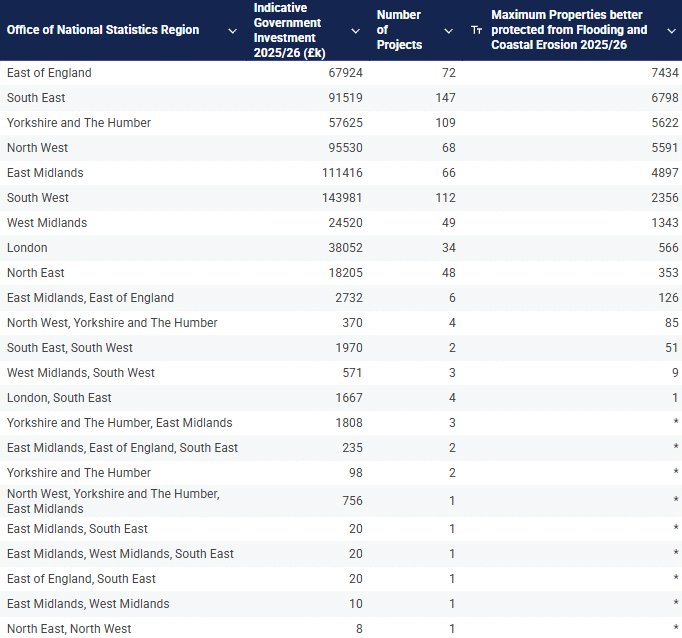Over 1000 New Flood Schemes Announced
The Government and Environment Agency are investing £2.65bn in over 1,000 flood defence schemes. Explore how this affects high-risk areas, aligns with NaFRA2, and informs decisions for property owners, planners, and developers.
The Government and Environment Agency’s latest announcement to fund over 1,000 new flood schemes marks a significant milestone in flood risk management. With climate change driving increasingly severe and frequent flooding events, this investment will play a crucial role in safeguarding homes, businesses and infrastructure. As a flood risk consultancy, we welcome this proactive approach, but how does it translate into real-world benefits and what does it mean in the context of the latest flood risk assessment models?
Key Takeaways
- The Government and Environment Agency has announced over 1,000 new flood defence schemes
- The investment aligns with the updated National Flood Risk Assessment (NaFRA2)
- Priority areas have been identified for flood defence improvements
- A mix of infrastructure and natural flood management techniques will be implemented
- According to the Environment Agency in 2025, For every £1 spent on flood protection, £8 is saved in avoided damages
Breakdown of the announcement
The Government has committed a record £2.65 billion over two years to fund over 1,000 flood defence projects across the country. This funding aims to protect thousands of homes and businesses from the increasing risk of flooding caused by climate change. The schemes will include a combination of hard engineering solutions, such as embankments and barriers, alongside nature-based solutions like wetland restoration and tree planting.
This year, the breakdown of spending includes:
- £430 million going towards construction
- £220 million on reinstating flood defences to their full standard of service
- Further funding is earmarked for repairing existing flood assets utilised in flood events, including pumps and warnings
What areas are going to benefit?
Schemes to receive funding this year include:
- Derby Flood Risk Management Scheme in Derbyshire, “Our City Our River”, which will receive £34.6 million and protect 673 homes.
- North Portsea Island Coastal Flood and Erosion Risk Management Scheme in Hampshire, which will receive £13.8 million and protect 1,081 homes.
- Preston and South Ribble Flood Risk Management Scheme in Lancashire, which will receive £10.4 million and protect 1,537 homes.
- Poole Bridge to Hunger Hill Flood Defences in Dorset, which will receive £12.2 million and protect 135 homes.
- Benacre and Kessingland Flood Risk Management Scheme in Suffolk, which will receive £10.1 million and protect 86 homes.
- Brighouse Flood Alleviation Scheme in Yorkshire, which will receive £5 million and protect 414 homes.
- Bridgwater Tidal Barrier Flood Defence Scheme in Somerset, which will receive £43 million.
- In the West Midlands, the Beales Corner project, which protects communities in Bewdley, will benefit from £2 million.
- Support for property flood resilience schemes across Leicestershire, Derbyshire and Nottinghamshire, receiving £2.5 million.
- Phase 3 of the Stallingborough Sea Defences along the Humber estuary, receiving over £7 million.
- A further £3.8 million will be spent to improve protection in Pevensey Bay, as part of work to repair local sea defences.
- There is also money for coastal defences along the south coast, including Eastbourne, Bognor Regis and Littlehampton, as well as reservoir maintenance works at Aldershot.
- The Government has prioritised £140 million to ensure that 29 schemes, which are in progress but struggling with cost pressures, can be delivered without further delays, protecting nearby communities as soon as possible. The list of supported schemes has also been confirmed by the Environment Agency and includes flood defences in Great Yarmouth and the Alverstoke Flood and Coastal Erosion Risk Management Scheme on the south coast.
A full list of schemes can be found on the Government’s website.
Schemes proceeding in 2026/7 and beyond will be subject to the routine Regional Flood and Coastal Committees (RFCC) consenting process and decisions at Spending Review 2025 (SR25), which will determine the allocation of government funding for that period.
The cost-benefit of flood defence
Flood resilience is not just an environmental concern; it is an economic imperative. According to the Environment Agency for every £1 spent on flood defences, the UK saves approximately £8 in avoided damages* This makes investment in flood protection one of the most cost-effective climate adaptation strategies available.
In 2025 Public First released their report ‘From risk to resilience: the case for flood resilient communities, economy and growth’. The report highlights the significant economic and social impact of flooding in the UK and emphasises the urgent need for enhanced flood-resilience measures. Key findings include:
- Flooding causes approximately £2.4 billion in physical damages to property and infrastructure annually, with projections indicating an increase to £3.6 billion by 2050 due to escalating flood risks.
- Flood events result in workers being unable to reach their workplaces for an average of 10 days, leading to an annual loss of £290 million in output.
- Each year of flooding exerts a decade-long downward pressure on the economy, amounting to at least £6.1 billion, and results in 46,000 fewer jobs than would otherwise exist.
The report underscores the necessity for decisive government action to invest in flood resilience, thereby safeguarding communities, protecting critical infrastructure, and supporting sustainable economic growth.
The link with NaFRA2
The National Flood Risk Assessment (NaFRA2) represents a significant improvement in how we assess flood hazards. By incorporating the latest climate projections and real-time data, NaFRA2 identifies areas at the highest risk with greater accuracy than ever before. This updated model underscores the urgency of flood defence projects, with many regions now classified as high risk set to benefit directly from the government’s planned interventions.
According to NaFRA2 data, the East Midlands, Yorkshire and the Humber, and South East regions (Office for National Statistics regions) have the highest number of properties in areas at high or medium flood risk. These regions account for about a half (52%) of the total number of properties in areas at high or medium flood risk from rivers and sea.
When analysing the list of schemes for 25/26, the areas where the most properties will be better protected from Flooding and Coastal Erosion align closely with NaFRA data, with high risk regions receiving an increase in investment including the South East, Yorkshire and the Humber and East Midlands.

*This is listed as 0 as per the database, actual numbers to be confirmed or subject to change.
How do I know if my land is at risk?
With growing emphasis from the Government on flood risk mitigation and climate resilience, identifying whether a site is at risk of flooding is becoming an essential early step for property owners, developers, estate managers and industry professionals.
We are excited to share the launch of FloodMetric, an advanced flood risk screening tool designed to streamline due diligence and planning applications for property owners, consultants, developers and architects. FloodMetric delivers instant, automated flood risk insights for any location – including policy, all sources of flooding and climate change data- helping you make informed decisions with accurate data and future risk projections. Please let us know if you would like further information, we are available to answer any questions.
About the Author
Request your free, expert quote now
Aegaea work alongside home owners, private developers, planning consultants, architects, local authorities, international development agencies and contractors. Aegaea know exactly how to help you.





